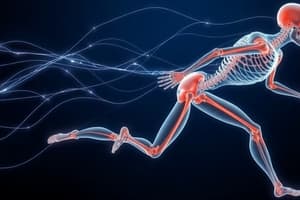Podcast
Questions and Answers
Which type of chain movement would be best suited for brushing teeth?
Which type of chain movement would be best suited for brushing teeth?
- Kinetic chain
- Open-chain (correct)
- Closed-chain
- Forceful chain
How does the human body apply force in closed-chain movements?
How does the human body apply force in closed-chain movements?
- Through a combination of tensile and compressive forces (correct)
- Through only tensile force
- Through neither tensile nor compressive forces
- Through only compressive force
Which of the following is NOT an example of a closed-chain movement?
Which of the following is NOT an example of a closed-chain movement?
- Standing still
- Pushing a grocery cart
- Squatting to pick up a box
- Typing on a keyboard (correct)
What is the term for the distance between the applied force and the joint axis?
What is the term for the distance between the applied force and the joint axis?
What is the primary benefit of open-chain movement for upper limb tasks like conducting an orchestra?
What is the primary benefit of open-chain movement for upper limb tasks like conducting an orchestra?
What type of forces do muscles transmit to the bones?
What type of forces do muscles transmit to the bones?
In lifting tasks, what must be overcome by the exerted force?
In lifting tasks, what must be overcome by the exerted force?
Which lever classification has the effort and resistance forces on opposite sides of the axis?
Which lever classification has the effort and resistance forces on opposite sides of the axis?
How is torque related to muscle function?
How is torque related to muscle function?
Which type of lever arrangement has the resistance closer to the axis than the effort force?
Which type of lever arrangement has the resistance closer to the axis than the effort force?
What role do the muscles of the core play in occupational performance?
What role do the muscles of the core play in occupational performance?
What is the mechanical advantage of a muscle related to?
What is the mechanical advantage of a muscle related to?
What distinguishes a third-class lever from other lever types?
What distinguishes a third-class lever from other lever types?
Flashcards
Open-chain Movement
Open-chain Movement
Movement where the distal joint moves freely in space, independent of other joints.
Closed-chain Movement
Closed-chain Movement
Movement where the proximal joint moves relative to a fixed distal segment.
Force
Force
Any push or pull of matter. In the body, it can be tensile (pulling) or compressive (pushing).
Resistance
Resistance
Signup and view all the flashcards
Exerted Force
Exerted Force
Signup and view all the flashcards
Muscle Moment/Torque
Muscle Moment/Torque
Signup and view all the flashcards
External Resistance
External Resistance
Signup and view all the flashcards
Effort Force
Effort Force
Signup and view all the flashcards
Lever
Lever
Signup and view all the flashcards
First-Class Lever
First-Class Lever
Signup and view all the flashcards
Second-Class Lever
Second-Class Lever
Signup and view all the flashcards
Third-Class Lever
Third-Class Lever
Signup and view all the flashcards
Study Notes
Kinetic Chains
- Kinetic chains refer to the cooperative movement of segments and joints in the body
- Open-chain movements occur in relation to a fixed nonmoving distal segment
- Closed-chain movements involve the proximal segment moving in relation to a fixed nonmovable segment
- Pushing a grocery cart is an example of a closed-chain function of the upper extremities
Principles of Physics, Forces, and Levers
- Force is a push or pull of matter
- Force can be tensile (pulling) or compressive (pushing)
- Moment is the turning effect of force about an axis
- Lever is a rigid bar that changes the direction or magnitude of force
- Levers in the body are classified based on the arrangement of the effort (muscle) in relation to the axis and resistance
Studying That Suits You
Use AI to generate personalized quizzes and flashcards to suit your learning preferences.




